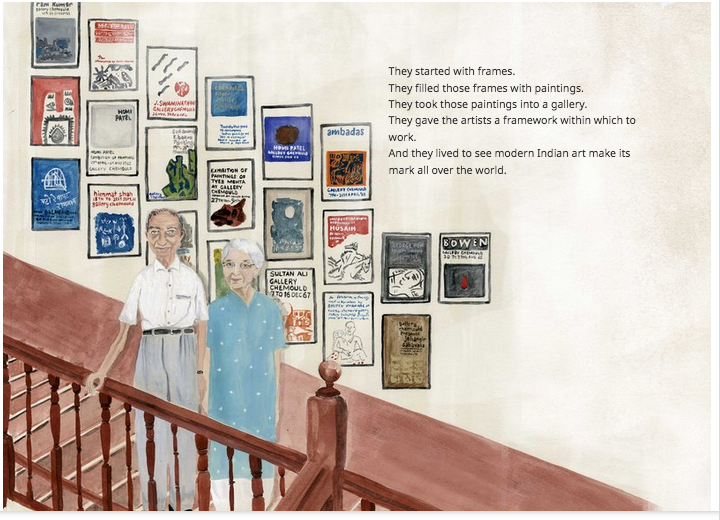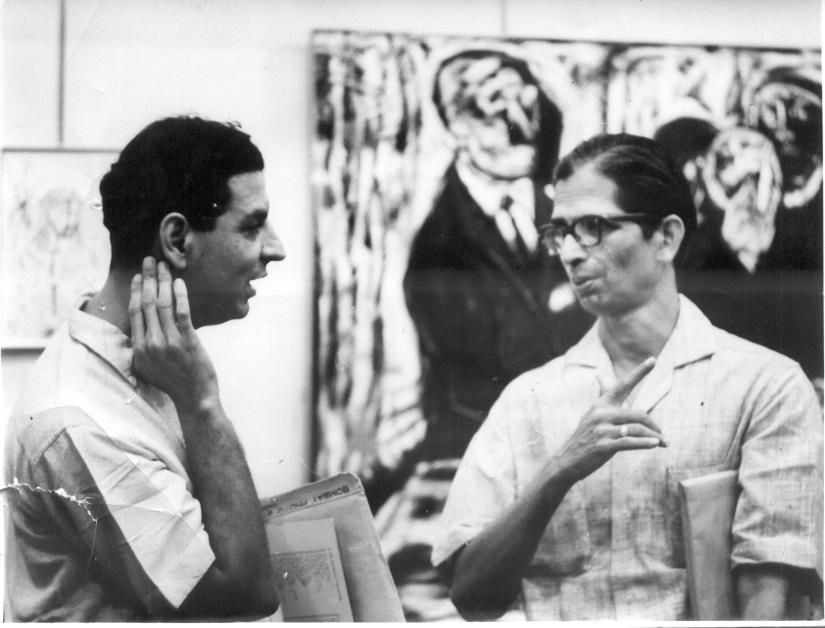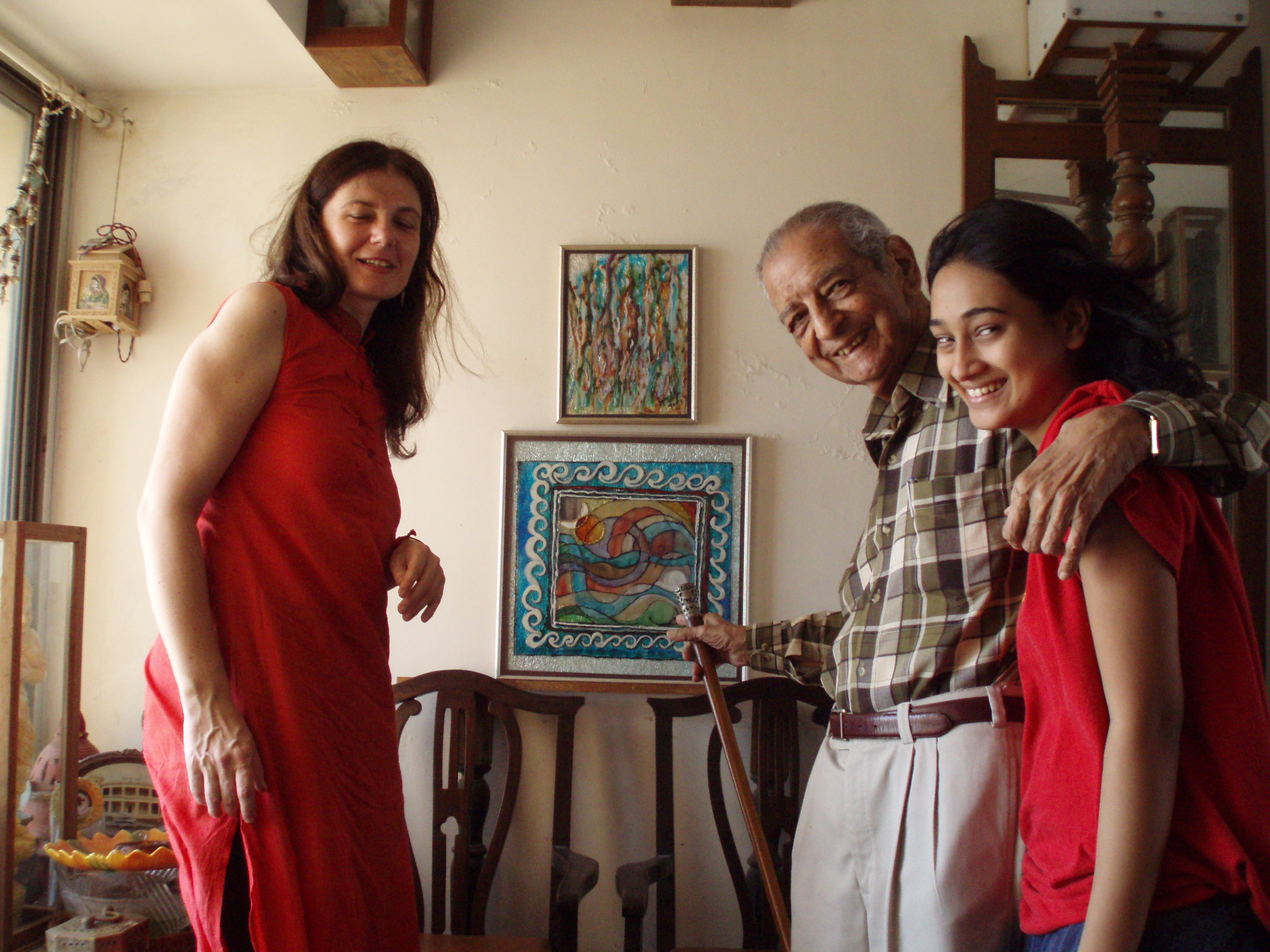Archive
Kekoo Minochair Gandhy
- Kekoo
- Minochair
- Gandhy
Kaikhushru
- 02-02-1920
- Mumbai (IN)
- 10-11-2012
- Mumbai (IN)
- Frame Shop OwnerGalleristArt Collector
Starting from a cosmopolitan milieu for young local artists, Kekoo and his wife Khorshed Gandhy developed a business model that turned the frame shop into Gallery Chemould.
Word Count: 27

Kekoo and Khorshed Gandhy in front of their life’s work. Drawing by Kripa in The Art Gallery on Princess Street by Jerry Pinto (Reprinted from: Pinto 2019, 28). 
Kekoo Gandhy in conversation with the painter K.K. Hebbar in front of Souza’s Death of the Pope, Taj Mahal Gallery, 1961 (Digital Photo Archive Margit Franz © Gandhy Archive, Mumbai; All Rights Reserved). 
Kekoo Gandhy with the author (far left) visiting a local artist and his family in his Mumbai home, 2007 (© Margit Franz; All Rights Reserved). 
Khorshed and Kekoo Gandhy in front of the oil portrait of their children Adil and Rashna by Walter Langhammer in their family house, Kekee Manzil, May 2007 (Photo: Margit Franz; All Rights Reserved). Bhatia, Sidharth. “The Accidental Gallerist and the Making of Indian Modern Art.” 8 July 2020, The Wire, thewire.in/the-arts/kekoo-gandhy-art-gallery-bombay. Accessed 4 February 2021.
Franz, Margit. “Exile meets Avantgarde: ExilantInnen-Kunstnetzwerke in Bombay.” Going East – Going South. Österreichisches Exil in Asien und Afrika, edited by Margit Franz and Heimo Halbrainer, CLIO, 2014, pp. 403–431. Academia, www.academia.edu/49079321/Exile_meets_Avantgarde_ExilantInnen_Kunstnetzwerke_in_Bombay. Accessed 16 June 2021.
Franz, Margit. Gateway India: Deutschsprachiges Exil in Indien zwischen britischer Kolonialherrschaft, Maharadschas und Gandhi. CLIO, 2015.
Gandhy, Kekoo. “Revival of art in India.” The Times of India, 30 November 1947, p. 14.
Gandhy, Kekoo, “The Beginnings of the Art Movement.” City of Dreams, special issue of Seminar, no. 539, August 2003, www.india-seminar.com/2003/528/528%20kekoo%20gandhy.htm. Accessed 15 April 2021.
Hoskote, Ranjit. “Kekoo Gandhy by Ranjit Hoskote. In memoriam: Kekoo Gandhy (2 February 1920–10 November 2012).” 10 November 2012, Out of Print Blog, outofprintmagazine.blogspot.com/2012/11/in-memoriam-kekoo-gandhy-by-ranjit.html. Accessed 15 April 2021.
Pinto, Jerry. The Art Gallery on Princess Street. Illustrated by Gieve Patel, Kripa B, Sudhir Patwardhan. Pratham Books, 2019. Storyweaver, storyweaver.org.in/stories/105518-the-art-gallery-on-princess-street. Accessed 16 June 2021.
Zitzewitz, Karin. The Perfect Frame: Presenting Modern Indian Art. Stories and Photographs from the Collection of Kekoo Gandhy. Chemould Publications and Arts, 2003.
Zitzewitz, Karin. “The Perfect Frame: Presenting Modern Indian Art. Stories and Photographs from the Collection of Kekoo Gandhy.” Christieʼs First Auction in India, exh. cat. Christie’s, Mumbai, 2013, pp. 28–37.
Word Count: 217
Private Archive Margit Franz, Sinabelkirchen: Audio file: Kekoo Gandhy in conversation with Khorshed Gandhy, Rashna Imhasly-Gandhy and son of Roger van Damme. Mumbai, n.d. (kindly provided by Rashna Imhasly-Gandhy; transcript Margit Franz). Archival records from personal interviews between the author and Khorshed and Kekoo Gandhy, Mumbai, 30 April to 3 May 2003; 18 to 22 January 2004; 26 April to 12 May 2007; 13 to 15 October 2008; 24 October 2010.
Bombay Art Society exhibition catalogues from 1938 till 1960.
Private Archive of late Khorshed & Kekoo Gandhy, Mumbai.
Times of India Archive via Staatsbibliothek zu Berlin:
http://erf.sbb.spk-berlin.de/historical-newspapers/. Accessed 18 April 2021.Word Count: 90
Kekee Manzil, Bandra Band Stand, Bandra, Bombay (now 43-A, Siraj Dokadia Road, HK Bhaba Rd, Mount Mary, Bandra West, Mumbai) (residence 1920-2012); Informal frame-shop, Sepulchre Brothers’ Office, Haroon House, Bazar Gate Street, behind Reserve Bank Building, Fort (now 23A, Haroon House, 294, Perin Nariman St, Fort, Mumbai) (workplace, until 1946); Frame shop, 271 Princess Street, Marine Lines, Bombay (now Shamaldas Gandhi Marg, Navajeevan Wadi, Lohar Chawl, Kalbadevi, Mumbai, Maharashtra) (workplace, since 1946); Jehangir Art Gallery, first floor, 161 B, Mahatma Gandhi Road, Kala Ghoda, Fort, Mumbai (workplace, 1963–2007).
- Bombay
- Margit Franz. "Kekoo Minochair Gandhy." METROMOD Archive, 2021, https://archive.metromod.net/viewer.p/69/2951/object/5138-7555936, last modified: 14-09-2021.
-
Rudolf von LeydenGeologistAdvertisement SpecialistJournalistArt CriticArt CollectorCartoonistBombay
The advertisement expert, Rudolf von Leyden, became a major art critic and art historian in Bombay in the 1940s, advocating an urgent need for modernism in art in post-colonial India.
Word Count: 30
Emanuel SchlesingerFactory OwnerTechnical DirectorArt CollectorArt CriticBombayThe art collector Schlesinger provided primarily financial aid by creating working opportunities for young artists in post-independence Bombay, and initiated the corporate culture of buying art.
Word Count: 26
Marg. A Magazine of Architecture and ArtMagazineBombayLocal and exiled creatives formed the Modern Architectural Research Group to publish a progressive journal of art and architecture in Bombay from 1946 onwards.
Word Count: 23
Iconic Photo of the Progressive Artists’ Group and Their AssociatesPhotographBombayThere are two versions of the PAG photo at the opening of M.F. Husain's first solo exhibition in 1950 (published in 1996 and 2003) and two narratives about the opening.
Word Count: 28
Schimmel’s Wedding Film 1948FilmBombayThe film shows Schimmel’s Jewish wedding ceremony at the prestigious Glamis Villa, followed by lunch at the Taj Mahal Hotel. Among the guests were Käthe and Walter Langhammer.
Word Count: 30
Open Studio Evenings by Käthe and Walter LanghammerSalonBombayThe painter Walter Langhammer and his wife Käthe built an informal infrastructure to promote local avant-garde artists and regularly invited them to Open Studio Evenings at their studio.
Word Count: 29
ChemouldGalleryFrame ShopBombayChemould’s history stretches from its beginnings as a manufacturer of chemical mouldings and frames in 1941 over to a hub for art circulation displaying a variety of artists in Bombay.
Word Count: 30
TIFRUniversity / Higher Education Institute / Research InstituteBombayThe TIFR is one of India’s premier scientific institutions. Inside its buildings, scientists ponder over path-breaking ideas. Also, within its hallowed walls is a fine collection of modern Indian art.
Word Count: 31
Bombay Art SocietyAssociationBombayOne of the oldest art societies in India founded by colonial rulers, Bombay Art Society showcased art students and professional artists from all over India, including the Progressive Artists of Bombay.
Word Count: 31
Air IndiaAirlineBombayAir India was one of the largest art collectors in Bombay. Indian art was used as branding for Air India in international competition right from the start.
Word Count: 27
Jehangir Art GalleryArt GalleryAuditorium HallLibraryBombayEfforts to create spaces for the democratic presentation, discussion and reflection of art in Bombay after independence led to the establishment of the Jehangir Art Gallery in 1952.
Word Count: 27